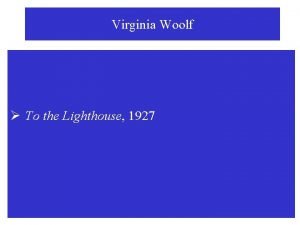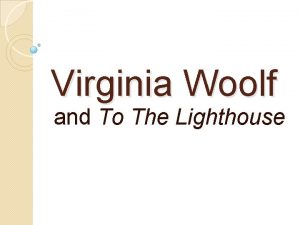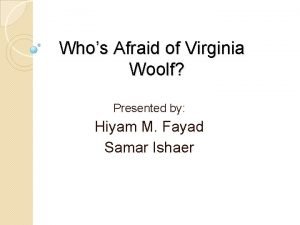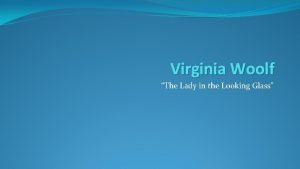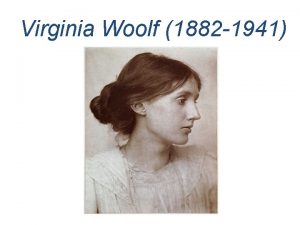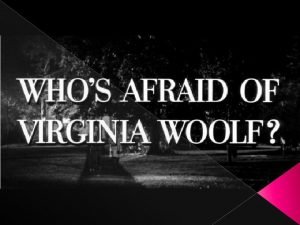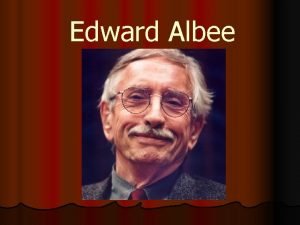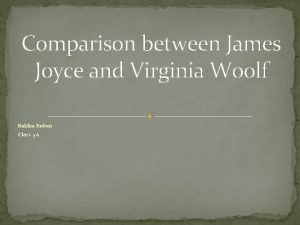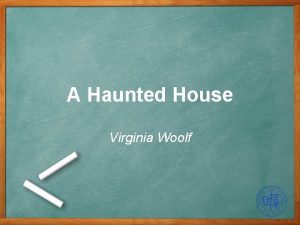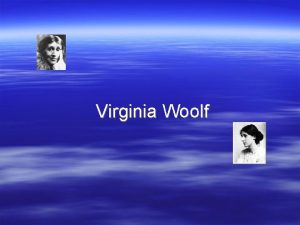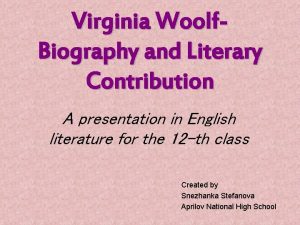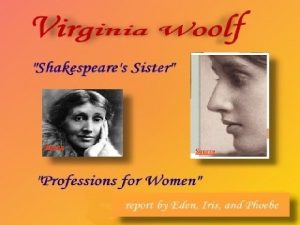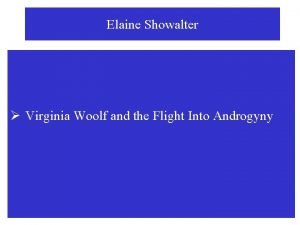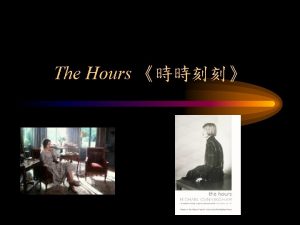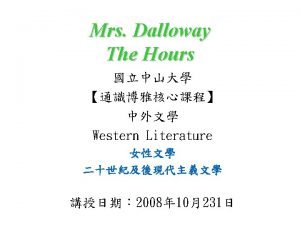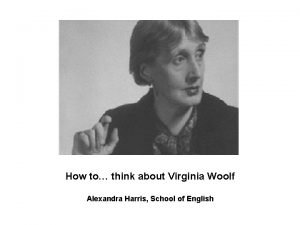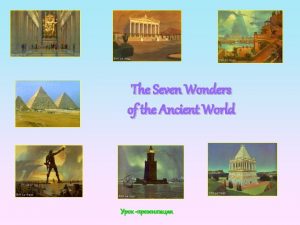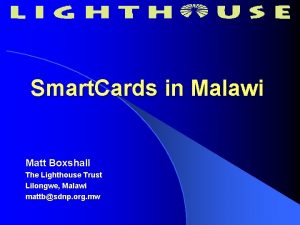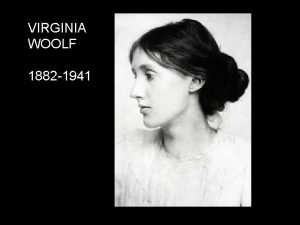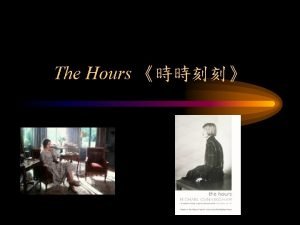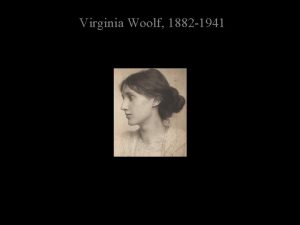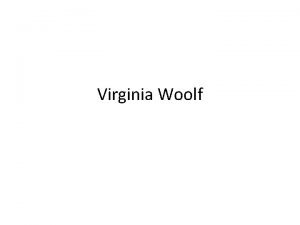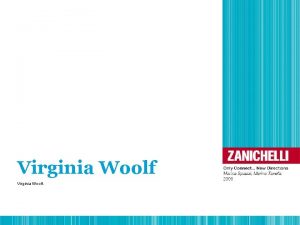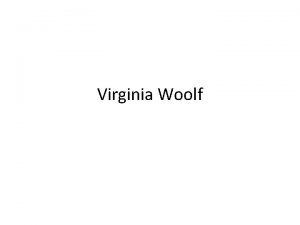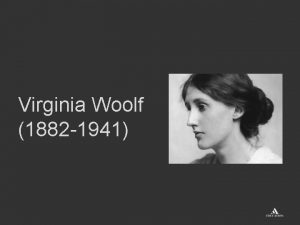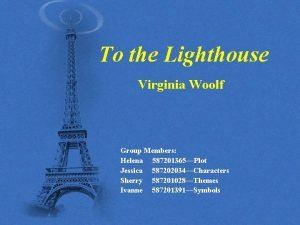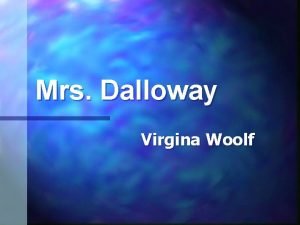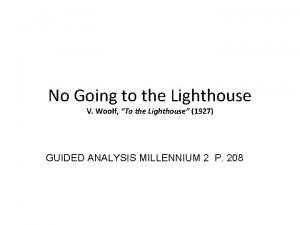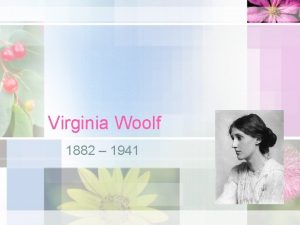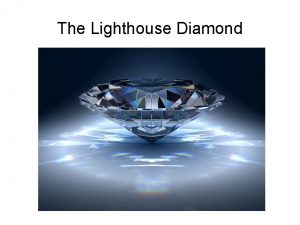To the lighthouse Virginia woolf WRITING STYLE IS




















- Slides: 20

To the lighthouse Virginia woolf

WRITING STYLE

IS IT A REALIST, MODERN, OR A POSTMODERN NOVEL? • Woolf’s disjointed story line would have been especially shocking to readers raised on Victorian novels, who were used to linear narratives, elaborate plots, and the mediating voice of an author. • Woolf eliminates these traditional narrative elements and presents her characters’ competing visions of reality. • Departing from the nineteenth century formalities of literary realism, Virginia Woolf used the stream-ofconsciousness technique in To the Lighthouse. • Follows and extends the tradition of modernist novelists like Marcel Proust, William Faulkner, and James Joyce. • a key example of the literary technique of multiple focalization, the novel includes little dialogue and almost no action. • most of it is written as thoughts and observations. • The novel lacks an omniscient narrator (except in the second section: Time Passes); • instead the plot unfolds through shifting perspectives of each character's consciousness. Shifts can occur even mid-sentence.

INFLUENCE OF FREUD’S PSYCHOLOGICAL THEORIES • Woolf's emphasis on consciousness and a character's inner lives • is consistent with the scientific and psychological ideas posited at the time. • As Sigmund Freud explored theories of consciousness and subconsciousness and raised questions regarding internal versus external realities. , Virginia Woolf wrote a novel that focuses not on the events of the external world but on the richness and complexity of mental interiority. • Through stream of consciousness technique.


DIFFERENCE BETWEEN WOOLF AND JOYCE’S STREAM OF CONSCIOUSNESS TECHNIQUE • Unlike James Joyce's stream of consciousness technique, Woolf does not tend to use abrupt fragments to represent characters' thought processes; • her method is more one of lyrical paraphrase. • Lacks an omniscient narrator which means that, throughout the novel, no clear guide exists for the reader and that only through character development can readers formulate their own opinions and views because much is ambiguous.

DIFFERENCE BETWEEN STREAM OF CONSCIOUSNESS AND INTERIOR MONOLOGUE • Although interior monologue is another term often used to refer to stream of consciousness technique, an important difference exists between the two. • Both stream of consciousness and interior monologue describe a character’s interior life. • But in interior monologue: the writer uses the character’s grammar and syntax. • In stream of consciousness technique: the character’s thoughts are transcribed directly, without an authorial voice acting as mediator. • Woolf does not make use of interior monologue; throughout To the Lighthouse. She maintains a voice distinct and distant from those of her characters. The pattern of young James’s mind, for instance, is described in the same language as that of his mother and father.

SUBJECTIVITY • So the novel is about the complex connection between feelings and memories. • To convey a sense of human consciousness and complexity of human psyche, Woolf's narrative departs from the traditional plot-driven structure as it is often expressed by an objective, third-party narrative. • Instead she incorporates highly innovative literary devices to capture thought process, using in particular stream of consciousness and free indirect discourse which makes the novel subjective. • Considering the subjectivity of the novel, it focuses on the subjectivity of reality, experience, and time. • one of the effects of Woolf’s narrative method is to suggest that objective reality does not exist. • The ever-shifting viewpoints that she employs construct a world in which reality is merely a collection of subjectively determined truths.


SYMBOLS










 Virginia woolf writing style
Virginia woolf writing style To the lighthouse virgina woolf
To the lighthouse virgina woolf Who's afraid of virginia woolf themes
Who's afraid of virginia woolf themes The lady in the looking glass analysis
The lady in the looking glass analysis Mrs dalloway setting
Mrs dalloway setting Tunneling technique woolf
Tunneling technique woolf Who's afraid of virginia woolf as an absurd play
Who's afraid of virginia woolf as an absurd play Who's afraid of virginia woolf themes
Who's afraid of virginia woolf themes Comparison between virginia woolf and james joyce
Comparison between virginia woolf and james joyce Summary of a haunted house by virginia woolf
Summary of a haunted house by virginia woolf Virginia woolf characteristics
Virginia woolf characteristics Virginia woolf presentation
Virginia woolf presentation Virginia woolf family tree
Virginia woolf family tree Virginia woolf
Virginia woolf Suicide note virginia woolf
Suicide note virginia woolf 1941-1882
1941-1882 Alexandra harris virginia woolf
Alexandra harris virginia woolf Northern virginia seo audit
Northern virginia seo audit Lighthouse seven wonders of the ancient world
Lighthouse seven wonders of the ancient world There's a lighthouse on the hillside
There's a lighthouse on the hillside Lighthouse malawi
Lighthouse malawi
